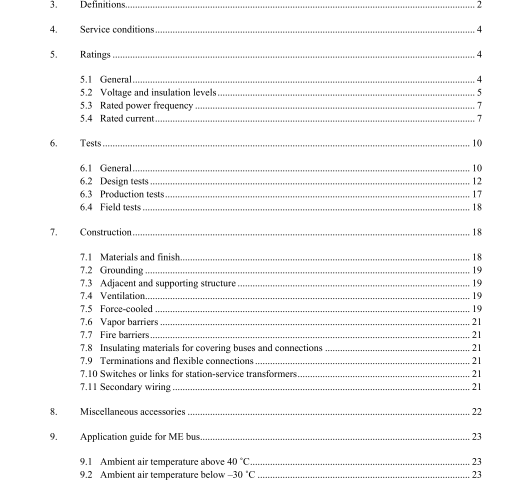IEEE C37.23-2003 pdf download.IEEE Standard for Metal-Enclosed Bus
3. Definitions
The definitions of terms contained in this standard, or in other standards referred to in this standard, are not intended to embrace all legitimate meanings of the terms. They are applicable only to the subject treated in this standard.
If a term is not defined in this standard, the definition in IEEE Std C37.100-1992 applies. An asterisk (*) fol- lowing a definition indicates that the definition in this standard is not contained in IEEE Std C37.100-1992; while a (+) indicates the definition differs from that in IEEE Std C37.100-1992. 3.1 ambient air temperature: The temperature of the surrounding air that comes in contact with equipment.
NOTE—Ambient air temperature, as applied to ME bus assemblies, is the average temperature of the surrounding air that comes in contact with the enclosure.
3.2 design tests: Those tests made to determine the adequacy of a particular type, style, or model of ME bus or its component parts to meet its assigned ratings and to operate satisfactorily under normal service condi- tions or under special conditions, if specified.
NOTE—Design tests are made only on representative apparatus to substantiate the ratings assigned to all other appara- tus of basically the same design. These tests are not intended to be used as a part of normal production. The applicable portion of these design tests may also be used to evaluate modifications of a previous design and to assure that perfor- mance has not been adversely affected. Test data from previous similar designs may be used for current designs, where appropriate.
3.3 enclosure: A surrounding case or housing used to protect the contained conductor and prevent personnel from accidentally contacting live parts
3.3.1 drip-proof enclosure: An enclosure, usually for indoor application, so constructed or protected that falling drops of liquid or solid particles that strike the enclosure at any angle not greater than 15 degrees from the vertical shall not interfere with the successful operation of ME bus.
3.3.2 nonventilated enclosure: An enclosure so constructed as to provide no intentional circulation of external air through the enclosure.
3.3.3 ventilated enclosure: An enclosure provided with means to permit circulation of sufficient air to remove an excess of heat, fumes, or vapors. NOTE—For outdoor applications, ventilating openings or louvers are usually filtered, screened, or restricted to limit the entrance of dust, dirt, rain, or other foreign objects.
3.4 field tests: Tests made after the assembly has been installed at its place of utilization.
3.5 metal-enclosed (ME) (as applied to ME bus): Surrounded by a metal case or housing, with provisions for grounding.
3.6 ME bus: An assembly of conductors with associated connection joints and insulating supports within a grounded metal enclosure. The conductors shall be rigid bus bar, but may include flexible connectors.
3.7 production tests (ME bus): Test made for quality control by the manufacturer on every device or repre- sentative samples, or on parts or materials required to verify during production that the product meets the design specifications and applicable standards.
NOTE—Production tests are sometimes called routine tests.
3.8 support components: These add additional strength and rigidity or both to the bus enclosure and are basic subassemblies of the enclosure.
3.9 termination (terminal chamber): A metal enclosure that contains all necessary mechanical and electri- cal items to complete the connections to other equipment.
3.10 types of ME bus assemblies: In general, three basic types of construction are used: nonsegregated- phase, segregated-phase, and isolated-phase.
a) Nonsegregated-phase bus. One in which all phase conductors are in a common metal enclosure without barriers between the phases. When associated with metal-clad switchgear, the phase conductors of a non-insulated bus assembly entering the switchgear assembly and connecting to the switchgear bus shall be covered with insu- lating material equivalent to the switchgear insulation system.
b) Segregated-phase bus . One in which all phase conductors are in a common metal enclosure but are segregated by metal barriers between phases.
c) Isolated-phase bus . One in which each phase conductor is enclosed by an individual metal housing separated from the adjacent conductor housing by an air space. The bus may be self-cooled or may be force-cooled by means of circulating a gas or liquid.IEEE C37.23 pdf download.IEEE C37.23-2003 pdf download
IEEE C37.23-2003 pdf download

Leave a Reply